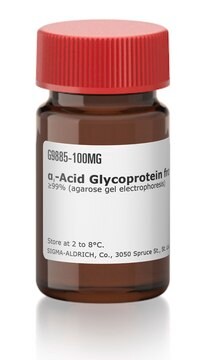H4652
HMG-1 Peptide
≥90% (SDS-PAGE), lyophilized powder, Histidine-tagged, human recombinant, expressed in E. coli
Synonyme(s) :
Amphoterin, HMGB1, High-Mobility-Group protein
About This Item
Produits recommandés
Nom du produit
HMG-1 human, lyophilized powder, ≥90% (SDS-PAGE), Histidine-tagged, recombinant, expressed in E. coli
Produit recombinant
expressed in E. coli
Niveau de qualité
Essai
≥90% (SDS-PAGE)
Forme
lyophilized powder
Poids mol.
25 kDa
Numéro d'accès UniProt
Conditions d'expédition
dry ice
Température de stockage
−20°C
Chaîne SMILES
COC(=O)CCCCCCCCCCCCCCO
Informations sur le gène
human ... HMGB1(3146)
Description générale
Application
- to prepare a standard curve for measuring HMG1 using ELISA (enzyme-linked immunosorbent assay) test
- to study the apoptotic ratios of Lewis cells in presence of exogenous HMG-1
- to study the changes in Th (T helper)-17 cell expansion in the presence of HMG-1 under in vitro conditions
- for the migration assay of GM7373 cells
Actions biochimiques/physiologiques
Forme physique
Remarque sur l'analyse
Mention d'avertissement
Danger
Mentions de danger
Conseils de prudence
Classification des risques
Aquatic Acute 1 - Aquatic Chronic 2 - Eye Dam. 1
Code de la classe de stockage
11 - Combustible Solids
Classe de danger pour l'eau (WGK)
WGK 3
Point d'éclair (°F)
Not applicable
Point d'éclair (°C)
Not applicable
Équipement de protection individuelle
dust mask type N95 (US), Eyeshields, Gloves
Faites votre choix parmi les versions les plus récentes :
Déjà en possession de ce produit ?
Retrouvez la documentation relative aux produits que vous avez récemment achetés dans la Bibliothèque de documents.
Notre équipe de scientifiques dispose d'une expérience dans tous les secteurs de la recherche, notamment en sciences de la vie, science des matériaux, synthèse chimique, chromatographie, analyse et dans de nombreux autres domaines..
Contacter notre Service technique





